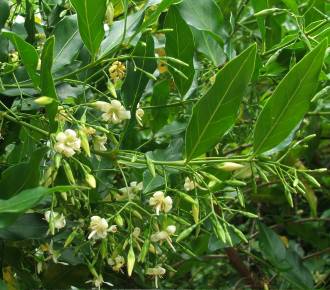Kraussia floribunda
Kraussia floribunda (Harv).
Family: Rubiaceae
Common names: rhino-coffee; renosterkoffie, wildekornoelie (Afr); isiKhukhankobe, isiKhubashane, uTholomba (Zulu)
SA Tree No: 700.1
Introduction
This is a pleasing garden shrub with faintly scented, attractive white flowers which appear in midsummer followed by a further season of interest in winter when a showy profusion of black berries are produced.

Description
Description
The growth habit of Kraussia floribunda is usually upright and can be either single or multi-stemmed 2-4 m tall. In the understory of other trees, it forms a sparse shrub which can reach tree size of approximately 6 m. Its stem bark is smooth and a grayish brown.

Leaves are borne in opposite arrangement from short petioles. Glossy leaves range from pale to dark green with light green undersides; they are variable in size (40-90 x 25-40 mm). The leaves are identifiable by wavy margins meeting at the tapering leaf tips. Bacterial nodes are usually present in small pockets at the base of lateral veins.

Clusters of pretty white flowers (10 mm in diameter) are borne from leaf axils on long stalks and are displayed attractively by hanging below the stems. The styles of these bisexual flowers are long and prominent. Flowering occurs between October to January followed by fruiting in January to May.
The fruits are spherical, about 8mm in diameter, purplish-black when mature and edible with a sweet flavour.

Conservation Status
Status
Kraussia floribunda appears on the 2009 Red List with the status of least concern and therefore can be considered to be widespread and abundant.
Distribution and habitat
Distribution description
Its habitat is variable ranging from forest margins to riverine vegetation, swamp forests and coastal grasslands of KwaZulu-Natal. Its frost tolerance is unknown. As its habitat is summer rainfall, it should be provided with good drainage in a winter rainfall garden.
Derivation of name and historical aspects
History
Kraussia after Dr. Christian Ferdinand Friedrich von Krauss (1812-1890) a German biologist who travelled and collected in South Africa. Floribunda likely refer to its abundance of hanging flowers.
Ecology
Ecology
The flowers are attractive to many insect pollinators but mostly flies. The edible fruit has a sweet taste and is enjoyed by animals and humans alike. This could explain the widespread distribution of this species from dispersal by small mammals, birds and monkeys. This plant is also enjoyed by black rhino and antelope who feed on the glossy foliage.
Uses
Use
This plant provides food for wildlife and due to the profusion of flowers (and thereafter berries) has great horticultural merit.
Growing Kraussia floribunda
Grow
When gardening with K. floribunda it is always best to bear in mind its natural habitat although it is by no means as demanding as its habitat may suggest. This attractive shrub will grow happily in part shade as it does under the forest canopy. It, however, performs much better in full sun.

This plant is suited to growth in a pot or container allowing its beauty to be enjoyed close up. It makes a lovely specimen plant but will also look good used in combination with other plants in a mixed flowering screen or informal garden bed. A good choice for a wildlife garden as it is so attractive to birds and other berry-loving insects and animals. In winter rainfall areas, as long as the summer is warm, it grow rapidly (approximately 60 cm per year) and will even tolerate dry, slightly alkaline soils. Faster growth can be achieved by increasing summer watering.
This plant is best propagated from semi hardwood cuttings in spring. Place in a well-aerated rooting medium - equal amounts of bark and polystyrene is recommended. The application of rooting hormone is recommended to increase success of rooting. Water consistently and rooting can be achieved within four weeks. After roots are established, pot on into a neutral to acid-loam medium.
Plants can also be grown very easily from seed. Sow in spring in well-drained soil mix and cover lightly with the sowing medium. To prevent pre- and post-emergence damping off the seed should be treated with a fungicide prior to sowing, or watered with a fungicide immediately after sowing. Transplant the seedlings after the first pair of true leaves has emerged, or when they are large enough to handle, into individual bags/pots. Feed generously with a liquid fertiliser and water moderately.
The plant has few pest or disease problems. To keep the plant healthy and vigorous feed the plant each season with an organic or inorganic fertiliser. K. floribunda responds very well to light pruning, only needed occasionally to lightly shape.
References
- Jackson, W. (1990) Origins and meanings of names of South African plant genera. UCT: Rondebosch.
- Johnson, D., Johnson, S. and Nichols, G. (2002). Gardening with Indigenous Shrubs. Struik Publishers, Cape Town
- Leistner, O.A. (ed.). 2000. Seeds plants of southern Africa: families and genera. Strelitzia 10. National Botanical Institute, Pretoria.
- Palgrave, K.C. (1983) Trees of South Africa (2nd Edition). Struik: Cape Town
- Pooley, E (1994) Field Guide to the Trees of Natal, Zululand and Transkei. Natal Flora Publications Trust: Durban.
Credits
Sarah Curtis & Cherise Vijloen
Kirstenbosch
November 2010
Plant Attributes:
Plant Type: Shrub, Tree
SA Distribution: KwaZulu-Natal, Limpopo, Mpumalanga
Soil type: Sandy, Clay, Loam
Flowering season: Spring, Early Summer
PH: Alkaline, Neutral
Flower colour: White, Cream
Aspect: Full Sun, Morning Sun (Semi Shade), Afternoon Sun (Semi Shade)
Gardening skill: Easy
Special Features:
Horticultural zones










Rate this article
Article well written and informative
Rate this plant
Is this an interesting plant?
Login to add your Comment
Back to topNot registered yet? Click here to register.